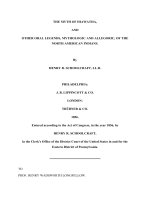- Trang chủ >>
- Khoa Học Tự Nhiên >>
- Vật lý
the myth of southern exceptionalism nov 2009
Bạn đang xem bản rút gọn của tài liệu. Xem và tải ngay bản đầy đủ của tài liệu tại đây (3.49 MB, 361 trang )
THE MYTH OF SOUTHERN
EXCEPTIONALISM
This page intentionally left blank
THE MYTH OF
SOUTHERN
EXCEPTIONALISM
Edited by
Matthew D. Lassiter and
Joseph Crespino
1
2010
1
Oxford University Press, Inc., publishes works that further
Oxford University’s objective of excellence
in research, scholarship, and education.
Oxford New York
Auckland Cape Town Dar es Salaam Hong Kong Karachi
Kuala Lumpur Madrid Melbourne Mexico City Nairobi
New Delhi Shanghai Taipei Toronto
With offi ces in
Argentina Austria Brazil Chile Czech Republic France Greece
Guatemala Hungary Italy Japan Poland Portugal Singapore
South Korea Switzerland Thailand Turkey Ukraine Vietnam
Copyright © 2010 by Oxford University Press, Inc.
Published by Oxford University Press, Inc.
198 Madison Avenue, New York, New York 10016
www.oup.com
Oxford is a registered trademark of Oxford University Press.
All rights reserved. No part of this publication may be reproduced,
stored in a retrieval system, or transmitted, in any form or by any means,
electronic, mechanical, photocopying, recording, or otherwise,
without the prior permission of Oxford University Press.
Library of Congress Cataloging-in-Publication Data
The myth of southern exceptionalism / edited by
Matthew D. Lassiter and Joseph Crespino.
p. cm.
Includes bibliographical references and index.
ISBN 978-0-19-538474-1; 978-0-19-538475-8 (pbk.)
1. Southern States—Historiography. 2. Regionalism—Southern States—
Historiography. 3. African Americans—Segregation—Historiography.
4. United States—Race relations—Historiography. 5. Southern States—
Social conditions. 6. Group identity—Southern States.
I. Lassiter, Matthew D., 1970–
II. Crespino, Joseph.
F208.2.M98 2009
975'.043—dc22 2009010766
9 8 7 6 5 4 3 2 1
Printed in the United States of America
on acid-free paper
PREFACE
“The white South’s uncontrollable urge to self-obituarize actually became a
steady source of supplementary income for a select squadron of the usual
academic and journalistic suspects who convened with amazing frequency
to deliver shamelessly recycled speeches at countless symposia dedicated to
kissing southern distinctiveness good-bye one more time.”
James C. Cobb, Away Down South
We begin with a confession. In March 2006, we convened a conference at
Emory University, the goals of which could be construed to resemble those
of the long line of southern symposia described above. We called the con-
ference “The End of Southern History? Integrating the Modern South and
the Nation.” We even invited Jim Cobb to speak. He indulged us with a gra-
cious, incisive, knee-slapping commentary on a panel. It was one of many
rich and provocative intellectual exchanges that took place that weekend,
as we debated whether to keep the question mark in the conference title,
take it out, or perhaps replace it with an exclamation point.
We organized the Emory conference in order to produce this anthology,
and we deliberately recruited half of the contributors from outside the
ranks of “southern history” as traditionally defi ned. Readers can decide
for themselves whether or not we offer something new or have simply
continued the recycling process, but it says something about the staying
power of the myths of southern exceptionalism that scholars can’t stop
having this debate. We should be clear that “kissing southern distinctive-
ness good-bye” was never really our goal. The concern that motivated our
conference and that informs this volume is not whether the South has
come to an end, so much as what it means to recognize that it is time for
a distinctive southern history and historiography to end.
We take it for granted that there is, and will continue to be, some entity
called “the South,” and that people will continue to love it or hate it,
defend it or deride it—or, in that great Faulknerian tradition, do all at the
same time. And we trust that readers will recognize that we are not arguing
vi PREFACE
that “there are no regional differences anymore” because “the South is the
same as every place else,” to reference some of the critiques that we have
heard in the process of compiling this book. Our concern is how the idea
of “the South”—defi ned as a unifi ed region that is not just different in
some matters of degree but exceptional from the rest of America and in
historical opposition to dominant national trends—has shaped and con-
tinues to shape the kinds of narratives that we tell about the region and
the nation. This book explores regional history and reconsiders southern
exceptionalism as a way to address broader questions about American his-
tory, the equally problematic category of “the North,” and the related
myths of American exceptionalism.
We are deeply indebted to each of the scholars who participated in
the conference at Emory. In addition to Professor Cobb and the contribu-
tors to this volume, they include Jane Dailey, Jacquelyn Dowd Hall, Doug
Flamming, Charles Payne, Bryant Simon, Susan Ashmore, Merle Black,
Michelle Brattain, Cliff Kuhn, Andrew Lewis, Allen Tullos, and Earl Lewis.
We thank, in particular, President Jimmy Carter and John Egerton for
their keynote addresses.
We are grateful to Emory University for granting us the resources to
assemble such a distinguished group of scholars, specifi cally the Emory
Conference Center Subvention Fund, Hightower Lecture Fund, Emory
Academic Exchange, and the Departments of History, African American
Studies, and Political Science. Becky Herring, Rosalyn Page, and Allison
Adams provided indispensable help with conference logistics. We also
thank Emory College and Dean Christine Levenduski for supplying funds
for the illustrations used in the book.
The anonymous peer reviewers provided many valuable suggestions
and wisely counseled us to clarify that this volume represents a contribu-
tion to the consolidation of a paradigm shift that has been under way for
some years now (in the academy much more than in popular discourse),
as the doctrine of southern exceptionalism has been exerting less and
less infl uence on the best scholarship about the South and about other
parts of the United States. Kevin Kruse has been instrumental in the devel-
opment of this book from the beginning, and he generously arranged
for us to present draft versions of our chapters to the Modern America
Workshop at Princeton University. Susan Ferber, our editor at Oxford Uni-
versity Press, supported this project with energy and enthusiasm from
its earliest stages, and she supplied great advice and welcome feedback
throughout the process.
Editing this anthology took much more time than we initially antici-
pated when the idea for a combined conference and book project began to
take shape in the hallways and bars of a conference meeting almost four
years ago. For their patience and for so much else, we especially thank
Tracy Davis, Caroline Herring, and Carrie and Sam Crespino.
CONTENTS
Contributors ix
Introduction: The End of Southern History 3
Matthew D. Lassiter and Joseph Crespino
Part I The Northern Mystique
1 De Jure/De Facto Segregation: The Long Shadow of a National Myth 25
Matthew D. Lassiter
2 Hidden in Plain Sight: The Civil Rights Movement outside the South 49
Jeanne Theoharis
3 Blinded by a “Barbaric” South: Prison Horrors, Inmate Abuse, and the Ironic
History of American Penal Reform 74
Heather Ann Thompson
Part II Imagining the South
4 Mississippi as Metaphor: Civil Rights, the South, and the Nation
in the Historical Imagination 99
Joseph Crespino
5 Black as Folk: The Southern Civil Rights Movement
and the Folk Music Revival 121
Grace Elizabeth Hale
viii CONTENTS
6 Red Necks, White Sheets, and Blue States: The Persistence of Regionalism
in the Politics of Hollywood 143
Allison Graham
Part III Border Crossings
7 A Nation in Motion: Norfolk, the Pentagon, and the Nationalization
of the Metropolitan South, 1941–1953 167
James T. Sparrow
8 The Cold War at the Grassroots: Militarization and Modernization
in South Carolina 190
Kari Frederickson
9 African-American Suburbanization and Regionalism
in the Modern South 210
Andrew Wiese
10 Latin American Immigration and the New Multiethnic South 234
Mary E. Odem
Part IV Political Realignment
11 Into the Political Thicket: Reapportionment and the Rise
of Suburban Power 263
Douglas Smith
12 Beyond the Southern Cross: The National Origins
of the Religious Right 286
Kevin M. Kruse
13 Neo-Confederacy versus the New Deal: The Regional Utopia
of the Modern American Right 308
Nancy MacLean
Index 331
CONTRIBUTORS
JOSEPH CRESPINO is Associate Professor of History at Emory University. He
is the author of In Search of Another Country: Mississippi and the Conservative
Counterrevolution (2007). He is currently working on a political biography of
Strom Thurmond.
KARI FREDERICKSON is Associate Professor of History at the University of
Alabama. She is the author of The Dixiecrat Revolt and the End of the Solid South,
1932–1968 (2001). Her chapter is drawn from a new book project, The Cold
War in Dixie: Transforming the Modern South, 1945–1980.
ALLISON GRAHAM is Professor of Communication at the University of
Memphis. She is the author of Framing the South: Hollywood, Television, and
Race during the Civil Rights Struggle (2001). She also has worked on two PBS
documentaries about the civil rights era, as associate producer of Hoxie: The
First Stand (2003), and co-producer of At the River I Stand (1993).
GRACE ELIZABETH HALE is Associate Professor of History at the University
of Virginia. She is the author of Making Whiteness: The Culture of Segregation in
the South, 1890–1940 (1998). Her chapter is drawn from a forthcoming book,
The Romance of the Outsider: How Middle-Class Whites Fell in Love with Rebellion
in Postwar America (Oxford University Press, 2010).
KEVIN M. KRUSE is Associate Professor of History at Princeton University.
He is the author of White Flight: Atlanta and the Making of Modern Conservatism
(2005), co-editor of The New Suburban History (2006), and co-editor of The
Spaces of the Modern City: Imaginaries, Politics, and Everyday Life (2008). His
x CONTRIBUTORS
chapter is drawn from a book in progress, One Nation Under God: Cold War
Christianity and the Origins of the Religious Right.
MATTHEW D. LASSITER is Associate Professor of History at the University
of Michigan. He is the author of The Silent Majority: Suburban Politics in the
Sunbelt South (2006) and co-editor of The Moderates’ Dilemma: Massive Resis-
tance to School Desegregation in Virginia (1998). His chapter is drawn in part
from a book in progress, The Suburban Crisis: The Pursuit and Defense of the
American Dream.
NANCY MACLEAN is Professor of History and African American Studies
at Northwestern University. She is the author of Freedom Is Not Enough: The
Opening of the American Workplace (2006); The American Women’s Movement,
1945–2000: A Brief History with Documents (2008); Debating the American Con-
servative Movement, 1945 to the Present, with Donald T. Critchlow (2009); and
Behind the Mask of Chivalry: The Making of the Second Ku Klux Klan (Oxford
University Press, 1994).
MARY E. ODEM is Associate Professor of History and Women’s Studies at
Emory University. She is the author of Delinquent Daughters: Protecting and
Policing Adolescent Female Sexuality in the United States, 1885–1920 (1995) and
co-editor of Latino Immigration and the Transformation of the U.S. South (2009).
DOUGLAS SMITH is Visiting Assistant Professor of History at Occidental Col-
lege and a John Randolph and Dora Haynes Foundation Fellow at the Hun-
tington Library. He is the author of Managing White Supremacy: Race, Politics,
and Citizenship in Jim Crow Virginia (2002). His chapter is drawn from a book
project on Reynolds v. Sims, Baker v. Carr, and the “reapportionment revolu-
tion” of the 1960s.
JAMES T. SPARROW is Assistant Professor of History at the University of Chi-
cago. His chapter is drawn from a forthcoming book, Americanism and Entitle-
ment: The Social Politics of Big Government in an Age of Total War, 1937–50.
JEANNE THEOHARIS is Endowed Chair in Women’s Studies and Associate
Professor of Political Science at Brooklyn College of the City University of
New York. She is co-author of Not Working: Latina Immigrants, Low-Wage Jobs,
and the Failure of Welfare Reform (2006), co-editor of Groundwork: Local Black
CONTRIBUTORS xi
Freedom Movements in America (2005), and co-editor of Freedom North: Black
Freedom Struggles Outside the South, 1940–1980 (2003).
HEATHER ANN THOMPSON is Associate Professor in the Department of
African American Studies and the Department of History at Temple Univer-
sity. She is the author of Whose Detroit: Politics, Labor and Race in a Modern
American City (2001). Her chapter is drawn from a forthcoming book on the
Attica prison uprising of 1971 and its legacy.
ANDREW WIESE is Professor of History at San Diego State University. He is
the author of Places of Their Own: African American Suburbanization in the Twen-
tieth Century (2004) and co-editor of The Suburb Reader (2006).
This page intentionally left blank
THE MYTH OF SOUTHERN
EXCEPTIONALISM
This page intentionally left blank
3
LITTLE ROCK, ARKANSAS, SEPTEMBER 1957. Three years after the Brown decision,
nine black students carefully selected by the Little Rock school board were
prepared to desegregate Central High School. Governor Orval Faubus, how-
ever, upended months of community preparations and defi ed the federal
court order by mobilizing the Arkansas National Guard to prevent “the
forcible integration of Negroes and whites.” On September 4, about one
hundred white onlookers and a throng of journalists watched the National
Guardsmen turn the black students away. Time magazine blamed Faubus
for manufacturing a racial crisis and observed that the vast majority of
white residents of Little Rock were ready to comply with the constitutional
requirement to desegregate their public schools. The governor removed the
National Guard after a three-week legal standoff, which allowed a mob of
four hundred segregationists to surround Central High when the “Little Rock
Nine” tried to enter for the second time. The mayor of Little Rock requested
federal assistance to prevent violence, and President Dwight Eisenhower
sent U.S. Army troops to restore order and avert a constitutional crisis. With
bayonets fi xed, members of the 101st Airborne escorted the black students
to school, and an international audience observed the fi rst military occu-
pation of a southern city since Reconstruction (fi gure I.1). These indelible
images soon became seared into the dramatic storyline of the civil rights
era: massive resistance to school integration, unruly white segregationists
confronting peaceful black activists, the exposed violence at the heart of
the Jim Crow system, a global humiliation in the Cold War struggle, the
latest stage in the South’s timeless defi ance of national norms.
1
INTRODUCTION: THE END
OF SOUTHERN HISTORY
Matthew D. Lassiter and Joseph Crespino
4 THE MYTH OF SOUTHERN EXCEPTIONALISM
LEVITTOWN, PENNSYLVANIA, AUGUST 1957. Two weeks before national and
international attention focused on the Little Rock Nine, the fi rst African-
American family moved into the model postwar suburb of Levittown, a
middle-class community of 60,000 located on the outskirts of Philadel-
phia. The NAACP previously had challenged the segregationist policy of
the Levitt Corporation, because the racially exclusionary mortgage pro-
grams of the U.S. government insured all of the homes in the all-white
development, but the federal courts refused to apply the Brown principle
to the allegedly private issue of housing discrimination. “If we sell one
house to a Negro family,” builder William Levitt explained, “then 90 to
95 percent of our white customers will not buy into the community.”
When William and Daisy Myers and their young children arrived at their
Levittown home, four hundred residents formed a mob that threw rocks
through their picture window, harassed them with loud music and car
horns, unfurled a Confederate battle fl ag, and burned a cross in the yard
of a neighbor deemed too friendly to the newcomers (fi gure I.2). The
governor of Pennsylvania dispatched state troopers to protect the Myers
family, leading to a week of violent confrontations between law enforce-
ment and the Levittown segregationists. Homeowners in the grassroots
FIGURE I.1. White students at Central High School in Little Rock watch as federal
troops escort six members of the “Little Rock Nine” to classes, October 16, 1957.
Six weeks earlier, Governor Orval Faubus mobilized the Arkansas National Guard to
prevent school desegregation in Little Rock. This forced President Dwight Eisenhower
to intervene in order to uphold the authority of the Brown decision. © Bettmann/
CORBIS.
INTRODUCTION 5
resistance movement blamed outside agitators in the NAACP for the
troubles and warned of a mass Negro invasion of their suburban enclave.
Before descending on Little Rock, the national media briefl y registered
the Levittown storyline: a “peaceful community suddenly turned upside
down by racial tension,” an unseemly eruption of racial prejudice in “a
Northern community in a state which legally has no color bars.”
2
Why do Americans remember Little Rock but not Levittown? Popular
narratives about the “American Dilemma” of racial inequality reinforce a
selective historical consciousness about the civil rights era, which is typi-
cally portrayed as an epic showdown between the retrograde South and a
progressive nation. Many students still learn about the civil rights move-
ment’s “classic period,” from the Brown decision of 1954 through the Vot-
ing Rights Act of 1965, through the fi lter of Eyes on the Prize dramas set
only in Little Rock, Greensboro, Albany, Birmingham, Selma, and rural
FIGURE I.2. August 20, 1957: Roughly two weeks before the Little Rock school
desegregation crisis, neighbors gather outside the home of Mr. and Mrs. William
Myers, Jr., the fi rst African-American family to move into the all-white community
of Levittown, Pennsylvania. The Myers family received police protection during
several weeks of threats and harassment from white homeowners in the Philadelphia
suburb, which typifi ed federally subsidized patterns of housing segregation in
postwar America. © Bettmann/CORBIS.
6 THE MYTH OF SOUTHERN EXCEPTIONALISM
Mississippi.
3
Published in 2007, on the fi ftieth anniversary of the concur-
rent riots in Levittown and Little Rock, a Pulitzer Prize-winning account
of “how America awakened to its race problem” celebrated the national
media coverage of the “shocking indignities and injustices of racial segre-
gation in the South” while barely even acknowledging parallel civil rights
confl icts in the North and West.
4
In recent years, academic historians have
dismantled the “myth of the liberal consensus” and excavated a “hid-
den era” of civil rights activism and white resistance in cities and suburbs
across the nation from the 1940s through the 1960s.
5
Yet the burgeoning
literature on the “long civil rights movement” has failed to alter popu-
lar understanding and journalistic tropes about the “Second Reconstruc-
tion,” a region-specifi c framework that keeps the spotlight focused on the
most troubled parts of the Deep South. In the traditional narrative (and
the second installment of the Eyes on the Prize documentary series), when
attention fi nally shifts northward and westward in the mid-1960s, urban
race riots and the Black Power movement emerge without historical con-
text as the catalysts for white backlash and the seemingly sudden “south-
ernization of American politics.”
6
These interpretations have contributed to a distorted account of politi-
cal realignment that attributes the rise of modern conservatism primar-
ily to white southern backlash against the civil rights movement. The
decline of New Deal liberalism and the ascendance of the New Right
“can be summed up in just fi ve words,” according to infl uential New York
Times columnist Paul Krugman: “Southern whites started voting Republi-
can. . . . End of story.”
7
The GOP dominates the South, in the conventional
wisdom summarized by political scientist Thomas Schaller, because of the
“southern strategy invented by Barry Goldwater, accelerated by Richard
Nixon, and perfected by Ronald Reagan.” Schaller’s Whistling Past Dixie
concludes that “southerners hold distinctly conservative values and have
long prided themselves for their obstinancy, for resisting the social trans-
formations unfolding elsewhere across America. . . . The South is differ-
ent . . . because it’s still full of southerners.”
8
These formulations ignore more than six decades of dynamic growth in
the metropolitan Sunbelt, the longstanding political divisions between the
Deep South and the much more populous states of the Outer South (where
a majority of white voters supported Eisenhower in the 1950s), and the
inconvenient fact that about one-third of the present-day southern elector-
ate consists of migrants born outside the region. The “southern strategy”
thesis is popular and ubiquitous precisely because it reduces a complex phe-
nomenon of national political transformation to another familiar story of
southern white backlash. Yet Richard Nixon and Ronald Reagan did not
need to learn their political strategies from southern demagogues such
as George Wallace. They honed their conservative platforms in the segre-
gated suburbs of postwar California, and each secured forty-nine states in
his presidential reelection campaign.
9
The current binary of red state–blue
INTRODUCTION 7
state polarization represents the latest version of this simplistic dichotomy
between southern backlash and American progress, an intractable region
alternately deviating from and dominating an otherwise liberal nation.
10
We argue in this volume that the notion of the exceptional South has
served as a myth, one that has persistently distorted our understanding of
American history. Although scholars and journalists have repeatedly chroni-
cled the decline of regional distinctiveness for more than a century now, the
basic features of southern exceptionalism still structure the popular mythol-
ogy of American exceptionalism—a story of white racial innocence (occasion-
ally compromised by the “southernization” of northern race relations), of a
benevolent superpower (that temporarily tasted the “southern experience”
of defeat after Vietnam), of an essentially liberal national project (if only the
red states would stop preventing the blue states from resurrecting the Great
Society).
11
In challenging southern exceptionalism, our agenda is not to
absolve the South but to implicate the nation. We write during an era domi-
nated by color-blind myths of American innocence from the burdens of the
past, when our political culture turns Martin Luther King Jr. into a sanitized
national hero, while the Supreme Court requires public school districts across
the nation to abandon racial integration plans by drawing a direct analogy
between affi rmative-action remedies and Jim Crow segregation.
12
Today the
“blue states” of the Northeast and Midwest have the nation’s highest rates of
school and housing segregation, but our suburban students from Michigan
and Atlanta and New England and Virginia know much more about the civil
rights movement in Mississippi and Alabama than they do about what hap-
pened in their own states and hometowns.
13
Discarding the framework of
southern exceptionalism is a necessary step in overcoming the mythology of
American exceptionalism, transforming the American Dilemma into a truly
national ordeal, and traversing regional boundaries to rewrite the American
past on its own terms and in full historical perspective.
The most insightful observers of southern history have always insisted
that the region is inseparable from the nation, that the South is not the
antithesis of a progressive America but, rather, has operated as a mirror
that reveals its fundamental values and practices. In The Southern Mystique,
published in 1964 as national attention focused on Mississippi’s racial vio-
lence, Howard Zinn argued that the American Dilemma “has never been
the tension between an American dream and Southern reality, but between
the American dream and national reality.”
14
In a similar fashion, C. Vann
Woodward’s Strange Career of Jim Crow (1955) located the origins of legal
segregation in the antebellum North and highlighted the nation’s com-
plicity in the establishment and maintenance of the South’s racial order.
While civil rights reform and economic modernization have “already
leveled many of the old monuments of regional distinctiveness,” Wood-
ward observed in 1958, “national myths have been waxing in power and
appeal, . . . national legends of opulence and success and innocence.”
15
In
1960, at the height of massive resistance to the civil rights movement, a
8 THE MYTH OF SOUTHERN EXCEPTIONALISM
new generation of southern historians marked the centennial of the out-
break of the Civil War with an anthology titled The Southerner as American.
The contributors attacked notions of southern exceptionalism and national
innocence, and they warned white southerners against a second “revolt
against the larger society of which they have always been a part, against
social values which they have always shared.”
16
More recently, James C.
Cobb has counseled historians not to defi ne “southern peculiarities solely
in relation to ‘the North.’ In this usage, the North actually represented
not simply another region . . . but an ‘emotional idea’ of the remainder of
a triumphantly superior America, . . . that mythical non-South [that] had
become virtually synonymous with the idea of America itself.”
17
The modern fi eld of southern history came of age during the reign of
the “liberal consensus,” when the myths of American exceptionalism were
at their most powerful, and when the confl ation of “the North” with a tri-
umphant narrative of American history was most pronounced. During the
early years of the Cold War, leading fi gures in southern history felt, with as
much anxiety as optimism, that traditional patterns of regional distinctive-
ness were giving way to the homogenizing forces of nationalization and
the bellicose ideology of the American Way. In this context, C. Vann Wood-
ward outlined an intellectual project of southern exceptionalism as a strate-
gic maneuver to critique the excesses of American empire, the underside of
American capitalism, and the myth of American innocence from responsi-
bility for the past. In a series of essays published during the 1950s, and then
compiled in The Burden of Southern History (1960), Woodward argued that
nothing in the South remained “immune from the disintegrating effect of
nationalism and the pressure for conformity” except for the unique history
of the region itself, the “collective experience of the Southern people.” He
therefore proposed that the South’s “un-American” historical identity—per-
vasive poverty instead of economic abundance, military defeat instead of
confi dence in inevitable victory, a “tortured conscience” instead of “moral
complacency”—could serve as the critical vantage point to defl ate the “illu-
sions and myths of American nationalism.”
18
Citing Woodward as inspira-
tion, David M. Potter then advised scholars to “confi ne Southern history
to phenomena which have some kind of regional distinctiveness” and to
exclude all “manifestations within the region of national phenomena.”
19
In short, liberal historians in the postwar decades called for a distinctive
southern history based not on a set of empirical differences between region
and nation but, rather, on the presumed divergence of a collective southern
identity from national myths and American ideals.
In retrospect, it seems clear that the strategy of policing the boundaries
of southern exceptionalism has done far more to sustain than to dismantle
the myths of American exceptionalism. In this sense, the problem of south-
ern distinctiveness should be of concern not only to regional specialists but
also to the many scholars of the “non-South” who have tended to ignore
this debate altogether.
20
“The South . . . has been an American problem,”
INTRODUCTION 9
Larry Griffi n and Don Doyle observe, “because it became the repository for
problems that were really ‘American’ all along and that were only thought
to be peculiar to the region and antithetical to mainstream American
values.”
21
For much too long, to take one prominent example, the sway of
the “liberal consensus” and the dominance of southern history in explora-
tions of the American Dilemma worked to obscure the transregional origins
and national (indeed transnational) scope of “Jim Crow” racial systems.
Recent scholars working outside of southern history have documented the
early segregation laws targeting Chinese immigrants in San Francisco in
the 1880s, the extensive history of statutory discrimination against Mexi-
can Americans in the Southwest, the exportation of racial apartheid as part
of the American twentieth-century imperialist project, the many northern
and western states that permitted or required black-white segregation in
public schools in the century before Brown, and the federal and municipal
policies that segregated metropolitan housing markets across the country.
22
New studies of the civil rights era also have critiqued the Little Rock/Levit-
town binary of de jure/de facto segregation, which rested on an untenable
regional dichotomy that naturalized the racial system in “the North” by
describing postwar metropolitan development, not on its own terms as an
emerging national (not simply northern) racial system, but as the amor-
phous opposite of the state-mandated Jim Crow system of the South.
23
The tendency to isolate distinctive regional characteristics from a nor-
mative American narrative has set southern history in false opposition
to an idealized national standard and has encouraged oversimplifi cations
and overgeneralizations about all parts of the country. At the same time,
the constant need to mine the South for its symbolic possibilities has
often come at the expense of exploring the deeper currents of American
history and the particular conditions of local places. Scholars, journalists,
and politicians frequently have compartmentalized outbreaks of racial
backlash in the “non-South” by drawing on a reliable reservoir of south-
ern metaphors: opposition to housing integration makes Cicero, Illinois,
the “the Selma of the North”; resistance to school desegregation means
Boston is “the Little Rock of the North”; ending affi rmative action makes
California the “Mississippi of the 1990s”; the racially motivated murder of
a black man in Queens is something “expect[ed] . . . to happen in the Deep
South.”
24
Civil rights activists often employed a related strategy of denounc-
ing racial discrimination in the North and West through direct analogies
to the specter of southernization: “No Mississippi Here!” implored the
unsuccessful open-housing movement in California in 1964 (fi gure I.3).
25
This framework attributes episodes of racism and racial violence inside the
South to the social and political structures of the region, while portraying
similar events elsewhere as anomalous incidents that really should have
happened down in Mississippi or Alabama.
26
When regional compart-
mentalization fails, the “southernization of America” metaphor works to
erase the longer trends of white backlash and political conservatism in a
FIGURE I.3. “No Mississippi Here!” In 1964, the fair-housing movement in
California charged that passage of Proposition 14, a ballot referendum to
restore the right to discriminate based on race and religion in the sale and
rental of property, would mean that “California would become another Mis-
sissippi.” The liberal coalition Californians Against Proposition 14 deployed
the metaphor of southernization in the attempt to preserve the 1963 Rum-
ford Fair Housing Act, but white homeowners in California did not need to
import their segregationist politics from the Jim Crow South. During the two
decades following World War II, public policies and private discrimination
combined to prohibit racial minorities from living in about 98 percent of
new suburban developments in the state of California. In 1964, 65 percent
of the state’s voters, and three-fourths of white residents of the suburbs, sup-
ported Proposition 14 and amended the state constitution to guarantee the
private right to discriminate. Courtesy of the Max Mont Collection, Urban
Archives Center, Oviatt Library, California State University, Northridge.
INTRODUCTION 11
different but equally problematic way. “The Southern Strategy therefore
had a Northern fl ank of fundamental importance,” according to the tor-
tured logic of a book about suburban opposition to housing integration in
the 1960s and 1970s; George Wallace showed Nixon and Reagan the way,
other scholars have written, after the Alabama governor’s (apocryphal)
epiphany that “the whole United States is southern!”
27
Historians and journalists have long walked a tightrope between search-
ing for the South’s distinctive characteristics and charting the “American-
ization” or “northernization” of the region.
28
This analytical confusion is
an inevitable result of the balancing act involved in a scholarly tradition
that has maintained the faith in southern exceptionalism, as the essential
foundation that legitimates the subfi eld of southern history, while simul-
taneously chronicling all of the ways in which the traditional South keeps
fading away. “For as long as people have believed there was a South, they
have also believed it was disappearing,” Edward Ayers has noted. “The
South has always seemed to live on the edge of extinction, the good as well
as the bad perpetually disappearing.”
29
In its bicentennial search for the
region’s essence, Time explained that a “New South has been proclaimed
in every generation. . . . The South has changed before—and remained the
same, through slavery and secession, independence and defeat, emanci-
pation, reconstruction and integration.”
30
Two decades later, the Wash-
ington Post characterized the South as “a land of oxymorons”—“of danger
and decorum, of wealth and want, of growth and stagnation, of promise
and compromise, of racial dissonance and racial harmony, of rampant
illiteracy and resplendent literature.” The Post concluded that “the riddle
of the South is this: To defi ne what it is, you must fi rst defi ne where it is. To
defi ne where it is, you must fi rst defi ne what it is.”
31
Drawing boundaries
around cultural identity rather than physical geography, David Goldfi eld’s
recent reaffi rmation of southern exceptionalism has identifi ed an alter-
native “historical consciousness,” because “there is something different
down in Dixie; the difference is real and deep, grounded in the region’s
distinctive past.” Despite dramatic changes in the economy, politics, and
race relations of the modern South, “there is a darkness in the southern
soul; the time-ticking bomb called history that confounds and burdens
the region still.”
32
Regions are culturally constructed spaces of the collective imagina-
tion and not simply coherent entities located inside clear lines on a map.
Almost every scholar who has pondered the question of southern excep-
tionalism ends up acknowledging that the region exists less as an actual
place than as a symbol, an expression of collective identity, an idea.
33
It
therefore seems problematic to stake out the boundaries of a historical
subfi eld and a geographic region through circular reasoning; by high-
lighting paradoxes, riddles, oxymorons, and the constructed nature of
memory and identity; by dissolving change and continuity into a single
phenomenon; or by citing historical burdens that ought to shape national
12 THE MYTH OF SOUTHERN EXCEPTIONALISM
and not merely regional consciousness. In rejecting the framework of
southern exceptionalism, we are not arguing that there are no varia-
tions among regions, or that political culture and political economy have
become practically identical every place in the nation. But most regional
characteristics cited as evidence of differences of kind are really differ-
ences of degree—such as rates of unionization or immigration, patterns of
religiosity or voting behavior, the pace and scale of urbanization or eco-
nomic change. Certainly by the second half of the twentieth century, if
not before as well, focusing on the South’s aberrant qualities compared to
the rest of the United States obscures much more than it reveals about the
fundamental questions of modern American history. In this volume, we
discard the artifi cial binaries that have governed the relationship between
“southern” and “American” history and that have contributed to an ide-
alized national narrative that obscures deep connections across regional
boundaries. Our goal is to explore how both southern and American his-
tory are transformed when the South is no longer exceptional but, rather,
fully integrated into the national narrative.
Regions are so central to the ways in which Americans think about issues
of politics, culture, economics, race relations, and identity formation that
even scholars trained to be skeptics rarely question the utility of making
broad claims about the North and the South, the Midwest and the West, and
more recently the Sunbelt and the Rustbelt. Yet a strong case can be made
that, of the various interpretative frameworks based on geography, region is
the most popular but also the most imprecise scale of analysis. Municipal,
state, and national boundaries also defi ne “imagined communities,” but at
least they have concrete political meanings and exercise actual policymak-
ing powers.
34
The metropolitan area captures a combination of population
density and economic integration, while the categories of urban, suburban,
and rural encourage comparative analysis across regional and even national
borders.
35
Much of the exciting recent research in “southern history,” in fact,
has been produced by scholars who position themselves in other subfi elds—
such as African-American, urban, political, social, gender, labor, cultural,
and Latino history—approaching their projects through comparative frame-
works and investigating national or transnational themes that happen to be
geographically located, in part, inside the generally accepted parameters of
the South. These welcome trends refl ect a belated but growing recognition
that for most residents of the South, as for most residents of other sections of
the United States, regional status is a less salient measure of personal identity
than other categories such as race, ethnicity, class, gender, religion, local-
ity, and especially nationality.
36
The greatest works of southern history have
always interpreted events in their broader national and international con-
texts, but if the time has come to rethink the borders of American history
in an era of globalization, then there are similar virtues to traversing rather
than reinforcing regional boundaries within the United States.
37









